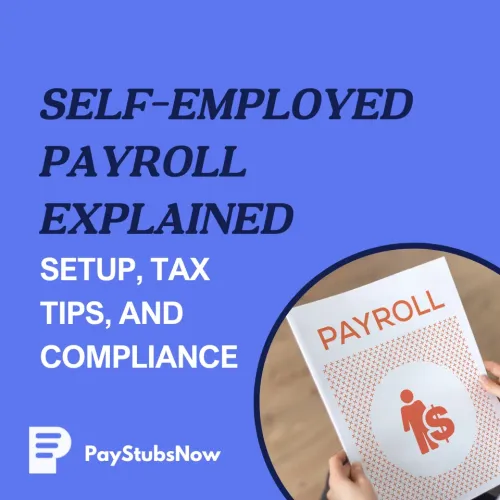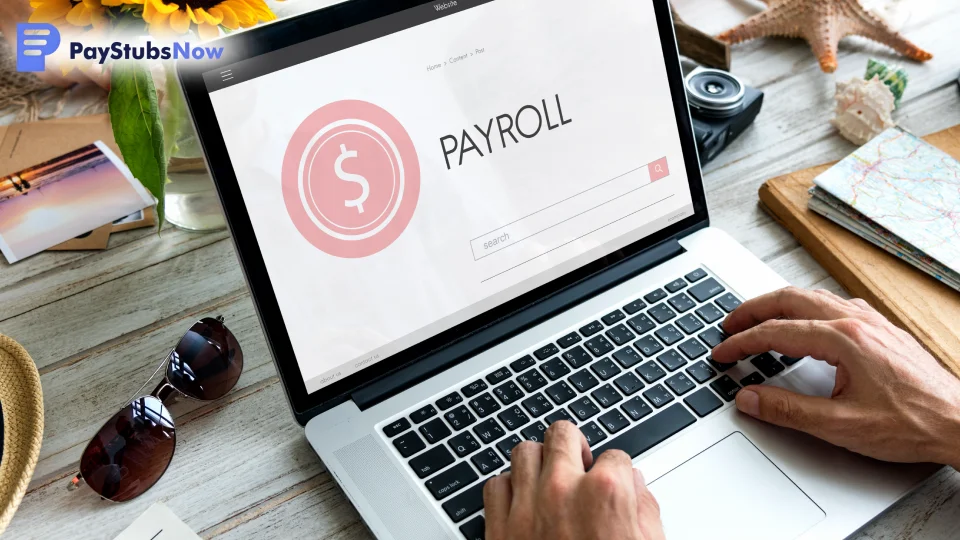


One of the biggest perks of being your own boss is that you get to set your own working hours and pace. But unlike traditional employees, you’re responsible for calculating and paying your own taxes. If you are just getting started with self-employed payroll, it’s helpful to know what the process entails.
This guide explains the essentials of self-employed payroll, offering clarity on setting up payments, understanding tax obligations, and complying with regulations to stay on the right side of the law.

Although the term "payroll" typically refers to the process of paying employees, for the self-employed, it involves the methods and systems used to compensate themselves from their business earnings.
As a self-employed individual, you have the freedom to choose how to compensate yourself, which may include methods like owner’s draws, salaries, dividends, or a combination of these. Each method offers different levels of structure, flexibility, and financial implications, allowing you to align your payment strategy with your unique business needs.
 When it comes to paying yourself as a self-employed individual, you have several options to choose from. Here's a brief overview of common approaches:
When it comes to paying yourself as a self-employed individual, you have several options to choose from. Here's a brief overview of common approaches:
This method allows you to draw money from your business earnings, providing flexibility in how much and how often you draw based on your business performance and cash flow.
Unlike a fixed salary, you have the liberty to adjust your income according to your business needs and availability of funds. This approach is popular among self-employed individuals who desire more control over their earnings.
Opting for a salary means paying yourself a fixed amount on a regular schedule, similar to how traditional employees are paid. This structure provides consistency in your personal finances and is a requirement for S-corporations where owners who provide substantial services to the business must be classified as employees.
These represent a portion of the company's profits that are allocated to its owners or shareholders. These payments are typically associated with limited liability companies (LLCs) and corporations. Unlike salaries, distributions or dividends do not constitute direct compensation for services rendered but are instead distributed following a profit-sharing model.
Many self-employed individuals strategically balance their income by combining a steady salary with distributions or draws from business profits. This blended method is particularly beneficial when you seek to maintain a baseline income for personal financial stability, yet also want the flexibility to capitalize on profitable periods.
The combination approach is commonly used by those with business structures like S-Corps or LLCs, as it can be customized to align with personal financial goals and business performance.
 While you may not have traditional "employees," effectively managing your finances as a self-employed individual requires a structured approach. Below are key steps to set up your payroll:
While you may not have traditional "employees," effectively managing your finances as a self-employed individual requires a structured approach. Below are key steps to set up your payroll:
Your business structure greatly influences how you pay yourself and your tax obligations. The IRS considers you self-employed if you operate as a sole proprietor, or independent contractor, are part of a partnership, or run your own business. Let's look at how different structures handle owner compensation:
Opening a separate business bank account is essential for distinguishing your business income and expenses from personal finances. This practice simplifies tax tracking and aids in building a business credit history.
To open a business account, you'll typically need to:
Figuring out a fair self-employed wage starts with researching market rates for the services you provide. Utilizing job listing platforms and salary comparison tools can offer valuable insights into appropriate compensation levels. Be cautious not to undervalue or misrepresent yourself, as doing so could invite audits and lead to additional taxes or fees.
When setting your rate, ensure it is practical and supports your business's growth. Saving a portion of your income for unexpected expenses is a wise strategy. Reflect on the value your contribution brings to your business, consider the nature of your work, and assess the overall income of your enterprise to establish a paycheck that truly reflects your efforts and achievements.
You can decide how frequently you want to pay yourself but establish a set pay period to maintain order. If you take owner draws or distributions, it might be best to pay yourself less frequently, especially as you understand your business's income patterns.
If you consider yourself an employee of your own business , you should pay yourself more frequently to match the standards of most employers. If you are in a partnership and receive guaranteed payments, make sure to follow a payroll process in agreement with your partners, such as ensuring monthly payments are made by the end of each month.
Choosing the right payroll management system is important for self-employment. Common options include manual systems, payroll software, and full-service providers. Each has its own advantages and disadvantages, so it's important to consider which option is best for your business expenses.
A manual payroll system requires manually handling all payroll tasks, including calculating pay, deducting taxes, and establishing pay frequencies. While it offers control, it requires significant time and knowledge of payroll and tax regulations. This method is prone to human error, which may result in penalties or audits.
Payroll management software automates tasks such as attendance and leave management and offers self-service portals for employees. Open-source payroll software is a cost-effective option for smaller businesses that need scalability. However, using software still requires an understanding of tax laws and regulations.
For a hands-off approach, businesses can opt for payroll providers like Paystubsnow. This platform offers an intuitive experience with generating payroll documentation, ensuring accurate tax calculations and compliance. This can save significant time and reduce the risk of errors, allowing you to focus on your core business activities.
Handling payroll taxes as a self-employed individual carries its own set of challenges. If your annual income exceeds $400, you are required to withhold taxes such as income tax and self-employment taxes, which include crucial contributions to Social Security and Medicare. Altogether, the self-employment tax rate is 15.3%, comprising 12.4% for Social Security and 2.9% for Medicare on your net earnings.
Under the Affordable Care Act (ACA), an additional 0.9% Medicare tax is levied for those in the high-earner bracket . This progressive tax applies at higher income levels, supplementing the standard self-employment tax returns.
Complying with these tax obligations is vital for legal reasons and to secure your contributions toward social benefits. As a self-employed individual, you are responsible for making quarterly estimated tax payments by the deadlines of April 15, June 15, September 15, and January 15 of the following year to avoid penalties. Calculating and remitting taxes as income is earned, rather than waiting for an annual reconciliation, is key. Consult with a tax advisor, if needed, to understand your specific tax obligations and ensure accurate and timely payments.
 Staying organized and compliant is crucial for smooth operations and avoiding tax issues. Here are some key best practices:
Staying organized and compliant is crucial for smooth operations and avoiding tax issues. Here are some key best practices:
Commingling funds can complicate your accounting and tax calculations. Maintain separate business and personal bank accounts and credit cards to simplify tracking income and expenses, which makes tax preparation and audits much easier to manage and understand.
Detailed records of every payment into and out of your business are essential. For owner's draws, note the date, amount, and purpose. This meticulous documentation supports accurate tax reporting and provides a clear audit trail if ever needed, ensuring transparency in your financial activities.
Leverage technology to streamline your financial management. Accounting software, spreadsheets, or services like Paystubsnow can automate record-keeping, track expenses, and generate reports. These tools save time, reduce errors, and provide valuable insights into your business's financial health.
Regularly assess your incoming and outgoing funds to understand your business's financial rhythm. Crucially, proactively allocate a portion of your earnings for estimated tax payments. This prevents a large tax burden at the end of the year and potential underpayment penalties.
Maintain precise records of all income sources and the time spent on various business activities. This is vital for accurate invoicing, determining profitability, and supporting your tax deductions. Detailed time tracking can also be essential if you bill clients hourly.
Even if you're not paying traditional employees, Paystubsnow offers valuable tools for self-employed individuals:
Easily create professional-looking paystubs that clearly document your income, whether you're taking owner's draws, paying yourself a salary as an S-corp owner, or recording distributions. This provides a formal record of your earnings.
When applying for loans or mortgages or during tax-related inquiries, having readily available and professional paystubs serves as verifiable proof of your income, streamlining these processes.
Unlike complex payroll software used by business owners who hire and pay employees, Paystubsnow offers a straightforward solution specifically for generating income documentation for yourself without the unnecessary features or learning curve.
Understanding self-employed payroll options and tax responsibilities and maintaining meticulous records can help you set up an efficient system. While the process differs from traditional employment, the need for clear and professional income documentation remains paramount.
Paystubsnow offers a streamlined solution for self-employed individuals to generate accurate paystubs, simplifying proof of income for tax filings, loan applications, and general financial organization. By providing a user-friendly platform to create essential financial documents without the complexities of full-scale payroll software, our platform empowers you to stay organized and compliant with ease. So, take control of your income documentation starting today